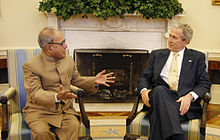Ministry of Finance (India)
Branch of Government of India | |
 Ministry of Finance | |
 North Block, Central Secretariat | |
| Agency overview | |
|---|---|
| Formed | 29 October 1946 |
| Jurisdiction | Government of India |
| Headquarters | Cabinet Secretariat Raisina Hill, New Delhi |
| Minister responsible | |
| Deputy Ministers responsible | |
| Agency executives |
|
| Child agencies |
|
| Key documents | |
| Website | finmin |
The Ministry of Finance (IAST: Vitta Maṃtrālaya) is a ministry within the Government of India concerned with the economy of India, serving as the Treasury of India. In particular, it concerns itself with taxation, financial legislation, financial institutions, capital markets, centre and state finances, and the Union Budget.[1]
The Ministry of Finance is the apex controlling authority of four central civil services namely Indian Revenue Service, Indian Audit and Accounts Service, Indian Economic Service and Indian Civil Accounts Service. It is also the apex controlling authority of one of the central commerce services namely Indian Cost and Management Accounts Service.
History[edit]
Sir Ramasamy Chetty Kandasamy Shanmukham Chetty KCIE (17 October 1892 – 5 May 1953) was the first Finance Minister of independent India. He presented the first budget of independent India on 26 November 1947.[2]
Department of Economic Affairs[edit]
The Department of Economic Affairs is the nodal agency of the Union Government to formulate and monitor country's economic policies and programmes having a bearing on domestic and international aspects of economic management. A principal responsibility of this department is the preparation and presentation of the Union Budget to the parliament and budget for the state Governments under President's Rule and union territory administrations. Other main functions include:
- Formulation and monitoring of macroeconomic policies, including issues relating to fiscal policy and public finance, inflation, public debt management and the functioning of Capital Market including Stock Exchanges. In this context, it looks at ways and means to raise internal resources through taxation, market borrowings and mobilisation of small savings;
- Monitoring and raising of external resources through multilateral and bilateral Official Development Assistance, sovereign borrowings abroad, foreign investments and monitoring foreign exchange resources including balance of payments;
- Production of bank notes and coins of various denominations, postal stationery, postal stamps; and Cadre management, career planning and training of the Indian Economic Service (IES).
The Foreign Investment Promotion Board (FIPB), housed in the Department of Economic Affairs, Ministry of Finance, was an inter-ministerial body, responsible for processing of FDI proposals and making recommendations for Government approval. FIPB is now abolished as announced by Finance Minister Arun Jaitley during 2017-2018 budget speech in Lok Sabha.[3]
Shri Ajay Seth is the current secretary of this department.[4]

Department of Expenditure[edit]
The Department of Expenditure is the nodal department for overseeing the public financial management system[5] in the Central Government and matters connected with the state finances. The principal activities of the department include a pre-sanction appraisal of major schemes/projects (both Plan and non-Plan expenditure), handling the bulk of the Central budgetary resources transferred to States, implementation of the recommendations of the Finance and Central Pay Commissions, overseeing the expenditure management in the Central Ministries/Departments through the interface with the Financial Advisors and the administration of the Financial Rules / Regulations /Orders through monitoring of Audit comments/observations, preparation of Central Government Accounts, managing the financial aspects of personnel management in the Central Government, assisting Central Ministries/Departments in controlling the costs and prices of public services, assisting organizational re-engineering thorough review of staffing patterns and O&M studies and reviewing systems and procedures to optimize outputs and outcomes of public expenditure. The department is also coordinating matters concerning the Ministry of Finance including Parliament-related work of the Ministry. The department has under its administrative control the National Institute of Financial Management (NIFM), Faridabad.
The business allocated to the Department of Expenditure is carried out through its Establishment Division, Plan Finance I and II Divisions, Finance Commission Division, Staff Inspection Unit, Cost Accounts Branch, Controller General of Accounts, and the Central Pension Accounting.
Dr. T. V. Somanathan is the current secretary of this department.[6]
Department of Revenue[edit]
The Department of Revenue function under the overall direction and control of the Secretary (Revenue). It exercises control in respect of matters relating to all the Direct and Indirect Union Taxes through two statutory Boards namely, the Central Board of Direct Taxes (CBDT) and the Central Board of Indirect Taxes and Customs (CBIC). Each Board is headed by a chairman who is also ex officio Special Secretary to the Government of India (Secretary level). Matters relating to the levy and collection of all Direct taxes are looked after by the CBDT whereas those relating to levy and collection of GST, Customs Duty, Central Excise duties and other Indirect taxes fall within the purview of the CBIC. The two Boards were constituted under the Central Board of Revenue Act, 1963. At present, the CBDT has six Members and the CBIC has five Members. The Members are also ex officio Secretaries to the Government of India. Members of CBDT are as follows:
- Member (Income Tax)
- Member (Legislation and Computerisation)
- Member (Revenue)
- Member (Personnel & Vigilance)
- Member (Investigation)
- Member (Audit & Judicial)
Shri Sanjay Malhotra (IAS) is the current secretary of this department.
Department of Financial Services[edit]
The Department of Financial Services covers Banks, Insurance, and Financial Services provided by various government agencies and private corporations. It also covers pension reforms and Industrial Finance and Micro, Small and Medium Enterprise. It started the Pradhan Mantri Jan Dhan Yojana.
Sanjay Malhotra is the current secretary of this department.[7]
This department has ownership over the following central government establishments.
Recruitment Bodies[edit]
National Apex Bodies[edit]
- Indian Institute of Banking and Finance (IIBF)
- Insurance Institute of India
- Institute of Actuaries of India
Regulatory Bodies[edit]
- Reserve Bank of India (RBI)
- Securities and Exchange Board of India (SEBI)
- Insurance Regulatory and Development Authority of India (IRDAI)
- Pension Fund Regulatory and Development Authority (PFRDAI)
- NPS Trust (NPS)
All India Financial Institutions[edit]
1. National Bank for Agriculture and Rural Development (NABARD)
2. National Housing Bank (NHB)
3. Small Industries Development Bank of India (SIDBI)
4. Export Import Bank (EXIM Bank)
5. National Bank for Financing Infrastructure and Development (NaBFID) (Came into force w.e.f. April 19, 2021)
Development Finance Institution[edit]
- Industrial Development Bank of India (IDBI)
- Industrial Finance Corporation of India (IFCI)
- Industrial Reconstruction Company of India (IRCI)
- Unit Trust of India (UTI)
- India Infrastructure Finance Company Limited (IIFCL)
- Agricultural Finance Corporation of India (AFCI)
- National Bank Financing Infrastructure and Development
- Board for Industrial and Financial Reconstruction
- Risk Capital and Technology Finance Corporation Limited
- Technology Development and Information Company of India Limited
- Discount and Finance House of India Limited
Central Public Sector Undertakings[edit]
Presently there are 13 nationalised banks in India.
- State Bank of India
- Bank of Baroda
- Union Bank of India
- Punjab National Bank
- Canara Bank
- Punjab & Sind Bank
- Indian Bank
- Bank of Maharashtra
- Bank of India
- Central Bank of India
- Indian Overseas Bank
- UCO Bank
- Jammu & Kashmir Bank
Presently there are 43 regional rural banks in India since 1 April 2020[8]
Andhra Pradesh
- Andhra Pragathi Grameena Bank[9]
- Andhra Pradesh Grameena Vikas Bank[9]
- Chaitanya Godavari Gramin Bank
- Saptagiri Gramin Bank
Arunachal Pradesh
- Arunachal Pradesh Rural Bank
Assam
Bihar
Chhattisgarh
- Chhattisgarh Rajya Gramin Bank
Gujarat
- Baroda Gujarat Gramin Bank
- Saurashtra Gramin Bank
Haryana
- Sarva Haryana Gramin Bank
Himachal Pradesh
- Himachal Pradesh Gramin Bank
Jammu and Kashmir
- J&K Grameen Bank
- Ellaquai Dehati Bank
Jharkhand
Karnataka
- Karnataka Gramin Bank
- Karnataka Vikas Grameena Bank
Kerala
Madhya Pradesh
- Madhyanchal Gramin Bank
- Madhya Pradesh Gramin Bank
Maharashtra
- Maharashtra Gramin Bank
- Vidharbha Konkan Gramin Bank
Manipur
- Manipur Rural Bank
Meghalaya
- Meghalaya Rural Bank
Mizoram
Nagaland
- Nagaland Rural Bank
Odisha
Puducherry
Punjab
- Punjab Gramin Bank
Rajasthan
- Baroda Rajasthan Kshetriya Gramin Bank
- Rajasthan Marudhara Gramin Bank
Tamil Nadu
- Tamil Nadu Grama Bank
Telangana
- Telangana Grameena Bank
Tripura
Uttar Pradesh
- Aryavart Bank
- Prathama UP Gramin Bank
- Baroda UP Bank[10]
Uttarakhand
West Bengal
- Paschim Banga Gramin Bank
- Bangiya Gramin Vikash Bank
- Uttarbanga Kshetriya Gramin Bank
3. Nationalised Insurance Companies
- Life Insurance Corporation
- General Insurance Corporation of India
- New India Assurance
- National Insurance Company Limited
- Oriental Insurance Company Limited
- United India Insurance Company
- Agriculture Insurance Company of India
4. Nationalised Financial Market Exchanges
- National Stock Exchange of India
- Bombay Stock Exchange
- Calcutta Stock Exchange
- India International Exchange
- Metropolitan Stock Exchange
- Commodity Exchanges
- Indian Commodity Exchange
- Multi Commodity Exchange
- National Commodity and Derivatives Exchange
- National Spot Exchange
Department of Investment and Public Asset Management[edit]
The Department of Disinvestment has been renamed as Department of Investment and Public Asset Management or 'DIPAM', a decision aimed at the proper management of Centre's investments in equity including its disinvestment in central public sector undertakings. Finance Minister Arun Jaitley had announced the renaming of the Department of Disinvestment in his budget speech for 2016–17. Initially set up as an independent ministry (The Ministry of Disinvestment) in December 1999, the Department of Disinvestments came into existence in May 2004 when the ministry was turned into a department of the Ministry of Finance. The department took up all the functions of the erstwhile ministry which broadly was responsible for a systematic policy approach to disinvestment and privatisation of Public Sector Units (PSUs).
Tuhin Kanta Pandey is the current secretary of this department.[11]
Department of Public Enterprises[edit]
The Department of Public Enterprises (DPE) which was earlier part of the Ministry of Heavy Industries and Public Enterprises was shifted to Ministry of Finance. Resulting in Finance Ministry having six departments while the Ministry of Heavy Industries and Public Enterprises was renamed to the Ministry of Heavy Industries. This shift was carried out to help in efficient monitoring of the capital expenditure, asset monetisation and financial health of the Central Public Sector Undertakings (CPSUs).[12]
See also[edit]
- National Institute of Public Finance and Policy
- Minister of Finance (India)
- Central Plan Scheme Monitoring System
References[edit]
- ^ "Home | Ministry of Finance | GoI". www.finmin.nic.in. Retrieved 16 March 2020.
- ^ Bharadwaj. Study Package For Clat. Tata McGraw-Hill Education. p. 248. ISBN 978-0-07-069937-3.
- ^ "Welcome to FIPB (India)". Archived from the original on 28 August 2011. Retrieved 16 May 2011.
- ^ "Meet the Secretary | Department of Economic Affairs | MoF | GoI". dea.gov.in. Retrieved 3 March 2020.
- ^ (PFMS)
- ^ "Who's Who".
- ^ "About the Department".
- ^ "list of SCB".
- ^ a b Kumar, N. Ravi (9 May 2019). "Rural banks to be merged in TS, AP". The Hindu.
- ^ "दैनिक जागरण: बैंकों का विलय : एक हुए UP के तीन बैंक, अब बड़ौदा यूपी बैंक नाम से जाने जाएंगे".
- ^ "Who's who". Department of Investment and Public Asset Management. Retrieved 15 January 2018.
- ^ "FinMin gets bigger: Department of Public Enterprises now part of Finance Ministry". Moneycontrol. 7 July 2021. Retrieved 13 August 2023.
External links[edit]
- Finance Ministry
- Official Facebook Page of Ministry of Finance, Govt. of India
- Income Tax department
- Central Board of Excise and Customs
- General Financial Rules: GFR 2017- Compilation of amendments, Website: www.gfr.co.in
